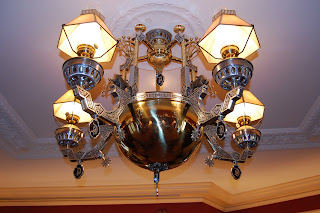When New Orleans Square was being built in the 1960s, Walt Disney envisioned a private apartment above the guest areas where he could entertain friends, family and business associates. Walt Disney passed away before New Orleans Square was completed, and the apartment idea was shelved. In 1987, the space above the entrance to Pirates of the Caribbean was opened as The Disney Gallery. The Gallery operated there for two decades before moving to Main Street so Walt's vision of a dream apartment could finally be realized.
Opened in early 2008 as part of the Year of a Million Dreams promotion, the Disneyland Dream Suite brought to spectacular life the designs and plans originally commissioned by Walt Disney so many years ago. Imagineering artist Dorothea Redmond, who had previously done illustration and set design for films ranging from Gone with the Wind to Rear Window, produced a series of watercolors as design inspiration for the suite.
Today's Imagineering team went back to those designs and recreated them as closely as possible. The sitting room (above and below) is the first room of the Dream Suite guests experience. Decorated in a French Provincial style inspired by the New Orleans surroundings, the room has been plussed with some unique Disney touches.
There's a full-size carousel horse at one side of the room, as well as wall paintings of Neuschwanstein Castle in Bavaria and the Chateau Chenonceau in France, the real-world inspirations behind the look of Sleeping Beauty Castle. The castle itself is seen in silhouette on the fireplace screen, behind which a faux flame sparks with magical fireworks. Those who really know their Disney history will even appreciate the small mechanical bird in a cage on the mantle. It's a working replica of one Walt Disney purchased on a trip to New Orleans, inspiring him toward the creation of Audio-Animatronics.
Off the main sitting room are two bedrooms. The decor of the one closest to Adventureland takes its cue from that exotic realm. At bedtime, a special "kiss goodnight" effects show transforms the room into a tropical paradise as mermaids appear in the painting above the bed and a familiar pirate ship silhouette soars across the face of the moon.
The Adventureland bedroom connects to the other side of the Dream Suite by way of an open air patio. The patio is especially beautiful at night, illuminated by Chinese lanterns and the flickering glow of fireflies (more Imagineering magic, of course).
The other bedroom in the suite draws inspiration from Frontierland, with dark woods accompanied by model trains and ships. A copy of Peter Ellenshaw's iconic painting of Disneyland hangs above an antique cast-iron stove.
As with all the rooms of the suite, details abound. Take this chandelier, for example, complete with spurs and sculpted bison... not to mention the distinctive Disneyland "D" on each gas key.
Hidden Disney elements are everywhere in the Disneyland Dream Suite. The "kiss goodnight" moment in the Frontierland bedroom sends the model trail chugging along the ledge, bringing to life the model vignettes seen there. One of these vignettes depicts a small band beside a sign labeled "ISIGNEY." This is actually a reference to Walt's family origins. The Disneys' earliest known relatives came from the village of Isigney on the northern coast of France. The name "d'Isigney" (of or from Isigney) was later anglicized, becoming "Disney."
Of course, the best known Disneys today are the brothers Walt and Roy. Their initials can be found in the ironwork (recently enhanced with gold leaf) of the Dream Suite's balcony, overlooking the Rivers of America.
It's a spectacular view and one of the best places in the park to watch Fantasmic! It's too bad neither Walt nor Roy ever got the chance to take it in themselves.
The Year of a Million Dreams has since ended, but the Disneyland Dream Suite still hosts the occasional guests, typically winners of a sweepstakes or other promotion tied to the park.



















































